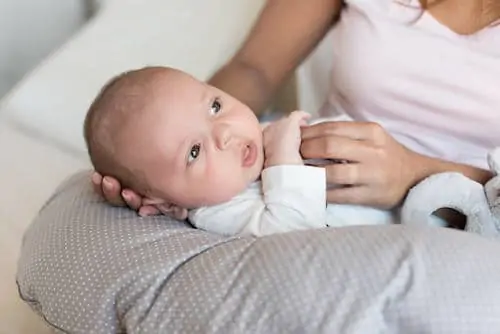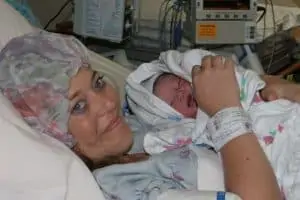Packing for a c-section can be slightly different than packing for a vaginal birth. If you’re planning a repeat or scheduled surgery, you can figure out what to pack in your hospital bag for a c-section.
When I had my first child, I went in for an induction and had no idea I might face a c-section. I had to send my mother out to get supplies I didn’t realize I needed or wanted to have with me in the hospital.
You don’t want to be in that same position. Your hospital bag (or bags) are your lifeline while in the hospital.
When I had my fourth child, I knew exactly what I needed to pack into my maternity bags. I wanted to share all of my must-have items with you to help you be prepared for everything to come.
How Many Bags Will You Need to Pack
I suggest that you pack three bags in total. You are going to need the following:
- A hospital bag for you
- A hospital bag for your partner
- A bag for the baby
While the hospital gives you most items you need for your baby while you are there, most parents want to get started with their items right away. I know I couldn’t wait to get my baby into all of the adorable clothes I had selected for them.
Your partner might want to pack his bag, but I suggest you provide some of the items I included here. My husband and I finally figured out what he needed when we packed for the fourth and final birth.
How Long Will You Be in the Hospital
When you have a vaginal birth, most hospitals only require you to stay one or two nights at most. Typically, you can be released after 24 hours, but it does depend on when the doctor can release you.
Important:
For c-sections, you can expect to stay for 48-72 hours. I typically leave around 48 hours, but I haven’t had any complications that required me to stay longer. So, that means you need to plan to stay for 2-4 days and have supplies to last that long.
To be sure, call your hospital before having your surgery. The labor and delivery floor nurses can give you a better idea of what to expect.
When Should You Pack The Hospital Bags?

You should have your bag packed by the time you are 36 weeks pregnant. Most scheduled c-sections take place when you are between 39 and 40 weeks pregnant.
However, your baby doesn’t have a memo in your uterus, letting them know to stay put. You can easily go into labor on your own and don’t want to scramble to pack a bag while in labor. I suggest printing a list in your eighth month of pregnancy and slowly packing items you know you want to take with you.
What to Pack for Mom
Alright, let’s get down to the items I always packed for myself. Remember, you don’t need to take pads or stool softeners to the hospital. Your hospital should provide all those things for you, but you need to have them at home.
- Comfortable Clothes
Everyone has a different definition of what they consider to be comfortable clothing. I know some women like dresses, but I cannot stand to wear dresses. Instead, I wear loose leggings, sweatpants, and loose tops.
Avoid any clothing that is tight or form-fitting. It will put too much pressure on your incision. You aren’t going to style either; you just had surgery. Comfort is more important than the looks of what you’re wearing.
- Nursing Bras
If you plan to breastfeed, bring one or two nursing bras. I selected nursing sleeping bras because they’re the most comfortable choice. You’ll be nursing a lot, so these bras make it easier.
- Nursing Tops
I liked nursing tank tops rather than actual shirts. Tank tops have a built-in bra shelf, so you don’t need to wear a bra. Wearing a tank top might not be practical depending on how cold the room is, so consider packing both.
- Nipple Cream
You’re going to need nipple cream if you’re breastfeeding. Slather the cream onto your nipple after each feeding. The hospital might give you lanolin, but lanolin needs to be wiped off before you breastfeed. Instead, look for a brand that doesn’t need to be removed first.
My absolute favorite nipple cream is Nipple Butter by Earth Mama Angel Baby. It smells like cocoa butter, soothes aching nipples, and doesn’t need to be removed before feeding your baby.
- Nursing Pillow

When you’re breastfeeding after a c-section, you want to avoid as much pressure on your incision as possible. I’ve found that using a nursing pillow is an essential item. Not only does it help with pressure, but if you have other kids, it acts as a barrier between your incision and the damaging knees of a toddler who wants to be held.
Here’s the list of the essential items to pack in your c-section hospital bag.
Many mothers swear by My Brest Friend Pillow because it provides plenty of stability for your nursing baby but also has back support.
- Socks
Hospital floors are freezing cold, and no one wants to walk barefoot in a hospital room. Pack several pairs of thick socks. My rooms always seemed cold, and when I hit 12 hours postpartum, I often went through a cold, shaking period. I need all the warmth possible.
- Slippers
Bring your favorite non-slip slippers. Once again, you’ll keep your feet warm, but once you start to get up and walk, you’ll want to have slippers to walk around the labor and delivery ward. My nurses encouraged me to walk around a bit at a time.
- A Sweater or Robe
As I mentioned, I felt these hospital rooms could be quite cold. Sweaters aren’t breastfeeding friendly, but you can toss one after feeding your baby. Robes are always a great choice. My husband bought me a soft, fluffy robe before we had our last baby, and I wore it most of the time in the hospital.
- Your Favorite Toiletries
Most of the time, the hospital will provide some basic toiletries, but you probably want to use your own. It makes you feel a lot more human and overall better when you take a shower. I even liked to put on a bit of foundation; it made me feel more like myself, and that matters when you sit in a hospital for 2-4 days.
Here are some toiletries to include in your maternity bag.
- Shampoo
- Condition
- Dry Shampoo
- Brush
- Body Soap
- Deodorant
- Facial Wash
- Toothpaste
- Toothbrush
- Basic make-up
- Hairdryer
- Hair Bands
I honestly never wanted to have my hair down when I was in the hospital. Once, I forgot to pack hair bands and sent my husband to get some. Toss that hair into a mom bun; you don’t have time to deal with it right now!
- Phone Charger
Whatever you do, don’t forget your charger. You’ll take many pictures, and your baby will sleep a lot. You’ll find yourself on social media, answering texts, making phone calls, or FaceTime with family.
- Glasses, Contact Lens Items
This doesn’t apply to everyone, but I know I’m close to the blind without my contact lenses or glasses. Some hospitals require that you take the contacts out before surgery, but mine did not. Bring both anyway, just to be on the safe side.
- Belly Band
C-section moms swear by belly bands. They help stabilize your incision and apply the much-needed pressure for coughing, sneezing, or moving. Not all hospitals provide their recovering mothers with a belly band, so try bringing one yourself.
- Snacks
By the time I can eat, I’m starving. My nurses were able to provide snacks in between meal times; they had prepared boxes with sandwiches, graham crackers, juices, and other goodies. However, I was starving, so by the time I had my third c-section, I knew I needed more snacks in my bag.
I brought protein bars, nuts, peanut butter crackers, and anything that I felt would be filling. I ate most of it!
- Headphones
You’ll be in the hospital for a while, so I found having a pair of headphones helpful. I listened to music or my favorite podcasts while I nursed and cuddled my new babies. My husband didn’t spend every moment in the hospital with me because we have other kids, so I did have alone time.
- Any Insurance Information
If you have any paperwork you need to bring with you or insurance information, such as a card, be sure to have everything in your wallet.
What to Pack for Your Partner
- 2-4 Changes of Clothes
Depending on how long you’ll be in the hospital and how long your partner will stay with you, you should include 2-4 changes of clothes. My husband did go back and forth, visiting our other kids. With our fourth child, he only stayed the first night; we didn’t have a babysitter for the second night.
Be sure he packs underwear, pajamas, a change of clothing, and socks.
- Toiletries
Your partner should have toiletries, too, especially if he stays in the hospital with you. He’s going to need to shower. Here are some things to include.
– Body wash
– Shampoo, if he uses any
– Deodorant
– Razors
– Toothpaste
– Toothbrush
– Hair products
- Phone Charger
Make sure he has his phone charger. Chances are he will spend plenty of time on his phone, so bring the charger.
- Pillows
Our hospital offered pillows and blankets, but my husband said they were pretty flat and stiff. So, he ended up bringing his pillows. The hospital blanket was fine, but everyone needed the right pillow to relax. A better idea would be to buy a U-shaped pregnancy pillow beforehand.
- Snacks
Just like me, he needed snacks too in his bag. His snacks looked different than mine, but he picked out what he wanted to have. He also had meals delivered to the room with mine, so he didn’t need to pack tons of food.
- Change or Money
Whether he was a soda, water, or a bag of chips, having change or cash on hand would make those trips to the machines much easier. I included plenty of change so he could get us whatever we wanted from the multiple vending machines throughout the hospital.
What to Pack for the Baby
- Car Seat
This won’t be in your bag, but you will need a car seat to take your baby home!
- Going Home Outfit
This is the outfit you have obsessively planned since you discovered the gender. Make sure you don’t forget to pack it.
- 2-4 Sleepers or Outfits
I typically bring sleepers to the hospital. I find they’re the easiest for all the nurses’ and doctors’ checks. You could include outfits instead. Pack 2-4 altogether.
- Socks
If you aren’t packing sleepers, make sure you include socks. Your baby’s toes will get cold fast in the hospital.
- Hat
I like to keep a hat on my baby in the hospital when we aren’t cuddling. The hospital does provide hats, but if you find something adorable that you need to bring with you, do!
- Swaddling Blankets
I have big babies; they all have been between 9-10lbs. The blankets in the hospital I found to be too small for big babies, and they aren’t ideal for swaddling. So, I packed my favorite muslin blankets. These are the perfect blanket for all seasons, making swaddling a breeze.
Things You Might Want to Bring
Gifts for Siblings
We brought sweet little gifts to the siblings from the new baby. It wasn’t anything significant, but it made them even more excited. We also had the kids pick out a gift for their new sibling that they presented at the hospital.
Entertainment for the Siblings
We do try to reduce the amount of time our kids spent in the hospital. My toddler attempted to lick the floor – no, thank you!
So, we included crayons, coloring books, and some little things for each kid. This helped when they were playing in the room with us as they met their new sibling.
A Book or E-Reader
You will have plenty of downtime. I spend most of the time in the hospital with my babies on my chest, doing skin-to-skin, sleeping, and nursing. I had plenty of time to read a few chapters in a book, but this isn’t necessary, nor does everyone like to read. You might want to cuddle and watch your favorite TV shows.
Underwear
I know some women packed underwear in their bags, but I can tell you – I never needed it. Those mesh panties that the hospitals include are perfect. Don’t feel bad about slipping a few pairs of mesh panties in your bag before you head home.
If you do decide to pack underwear, go for the big pairs. They need to go up over your incision, so it doesn’t rub or cause discomfort.
What You Don’t Need to Pack
- Pads
- Jewelry
- Valuables
- Diapers and Wipes
Final Thoughts
Figuring out what to pack in your hospital bag for your c-section doesn’t need to be hard. I hope these ideas can make packing easier and ensure you don’t forget anything at home!
Hey, this is Linda. My biggest accomplishment in life is being a mother of four children. Their current ages range from almost ten years old down to 20 months old.
I’m passionate about writing parenting articles because I understand so well all of the problems and trials you face as a parent. From breastfeeding woes to budgeting problems and behavior problems, along with everything in between, chances are I’ve faced it over the last ten years. Read more about Linda here.







